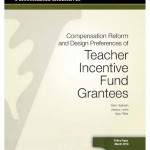Compensation Reform and Design Preferences of Teacher Incentive Fund Grantees
In U.S. K-12 public education, incentive pay for educators remains firmly fixed as a high-interest policy topic and has recently become a popular reform initiative in many school systems. The Teacher Incentive Fund (TIF), created in 2006 by the U.S. Department of Education, is at the forefront of this policy movement and has provided hundreds of millions of federal dollars for the implementation of incentive pay systems for teachers and principals. This paper examines the incentive pay plans implemented under the TIF program as of the 2009-10 school year, a reasonable starting point to understanding how federal dollars are being used to modify systems for compensating educators. Primarily drawing upon survey findings, researchers address the following questions: (a) What are the overall objectives of TIF plans? (b) How do sites determine bonus award eligibility? and (c) How are bonus awards distributed and to whom? Overall, TIF plans focus on rewarding educators’ performance in addition to recruiting and retaining educators in hard-to-staff positions. Most plans are designed in ways that limit excessive competition between educators, but they differ considerably in the actual dollar amount of bonus awards offered to educators. As the TIF program is set to receive $600 million dollars this year through federal appropriations and the American Recovery and Reinvestment Act, the findings from this report are particularly relevant and will allow policymakers and practitioners alike to learn more about how school systems are modifying educator compensation and what those choices might ultimately mean for teaching and learning within the nation’s public schools.
To view a copy of this paper, please click here.

Connect with Vanderbilt
©2026 Vanderbilt University ·
Site Development: University Web Communications